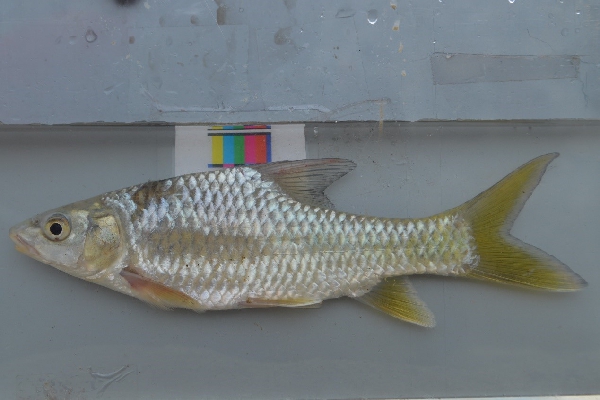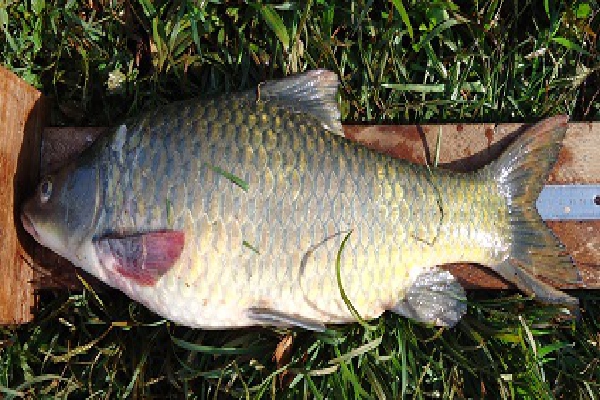Common names:
Ripon berbel, Barbel
None
Taxonomic tree
Kingdom: Animalia
Phylum: Chordata
Class: Actinopterygii (ray-finned fish)
Order: Cypriniformes (Carps)
Family: Cyprinidae (Carps)
Genus: Labeobarbus
Species: Labeobarbus altianalis (Boulenger, 1900)
Number of Occurrancies: 729
Etymology (Sharpf & Lazara 2018)
Labeobarbus: labeo, one with large lips, i.e., Barbus (historically a catch-all genus, now in Barbinae, for many African cyprinids) with “unusually thick fleshly lips”, referring specifically to L. nedgia [not to be confused with Labiobarbus van Hasselt 1823 in Labeoninae]
altianalis: altus, meaning high; analis, meaning anal; referring to long anal-fin ray, 5/6 length of head, “nearly reaching caudal when folded”
Synonyms: click here to view synonym
Type locality:
Jinja, Ripon Falls and Kakindu, Victoria Nile, Uganda. Syntypes at British Museum of Natural History (BMNH)
General idenfication features for cyprinids
A naked head (=without scales); jaws completely devoid of teeth; one or two pairs of circum-oral barbel, which are, however, absent in some species; no adipose fin; and presence of a sickle-shaped paired pharyngeal bones, each bearing 1-3 series of teeth
Distinguishing characters for the genus
Origin of the dorsal fin is above the pelvic fin base, or very slightly in advance of, or behind this point with no naked cheek below the eye (vs. Rastrineobola and Engraulicypris: almost entire dorsal situated above the anal fin plus the cheek below the eye covered by thin sub-orbital bones; Labeo: greater part of dorsal fin in advance of pelvic fin base plus a flap of skin immediately in front of the upper lip and ; Garra: greater part of dorsal fin in advance of pelvic fin base plus a circular disc on the chin confluent with lower lip; and Leptocypris (formerly Balilius): greater part of the dorsal fin in advance of the anal fin plus cheek covered by sub-orbital bones).
Distinguishing characters for species
- Exposed surface of the scales with numerous longitudinal striae (distinction from all other Labeobarbus and Enteromius spp. except L. bynni)
- Dorsal fin with III-IV, 8-9 rays, the last unbranched ray strong and bony, from 0.5-0.75 the length of the head (distinction from L. bynni whose last unbranched ray is as long as, or, longer than the head)
- Depth of body equal to, or slightly greater than the length of the head, which is contained 3-4.33 times in standard length; in some fishes the head does not pass interceptibly into the body; instead, there is a well-marked hump at the nape
- The base of pelvic fins is situated below the anterior rays of the dorsal fin
- Two pairs of barbels, the anterior somewhat shorter than the eye, the posterior as long as the eye
- Snout rounded or somewhat acute, its length contained 2.5-3.5 times standard length
- Mouth inferior; lips varying in shape and size from thin to fleshy, the latter often produced into larger upper and lower lobes; Fishes with well developed lips have the snout rather fleshy (not a sexual difference except that older fishes seem to have more thickened lips than young fishes)
- Eye diameter contained 3 (in young) to 7 times in head length
- Lateral line with 32-39 scales; 5.5-6.5 scales between the lateral line and the dorsal ray; 2.5-3.5 scales between the lateral line and pelvic fin base
- Caudal peduncal as long as deep
- Colour is variable depending on habitat; generally tarnished silver in young fishes, becoming golden-green in adults
Special taxonomic remarks:
- The species is commonly refered to in old literature as Barbus altianalis; here, we follow the currently accepted nomenclature with the the large hexaploid species in being placed in Labeobarbus and small diploid species in Enteromius (Van Ginneken et al., 2017). The former genus also includes the species of its junior synonym Varicorhinus (Vreven et al., 2016).
- Previously recognised sub-species based on geographical location: Labeobarbus altianalis radcliffii (Lakes Victoria and Kyoga, and Victoria Nile) and L. altianalis eduardianus (Lakes Edward and George) are now synonyms of L. altianalis
- Young L. altianalis do not closely resemble adults.
- The species closely resembles L. bynni, except that the body is shallower and the last unbranched dorsal ray is shorter than the head.
Distribution in Uganda
Lakes Victoria, Kyoga, Edward and George, Kazinga channel, and Victoria Nile
Occurence
Native
Habitat
Benthopelagic; common in shallow inshore waters but also in fast-flowing waters of rivers
Feeding
Omnivorous; feeds on molluscs, aquatic vegetation, fishes (particulary small haplochromines) and insect larvae
Biology
The maximum recorded specimen was 90 cm. Adults move upstream to the rivers during the raing season to spawn, and juveniles are associated with the rivers
Economic importance/End use
The species contributes to subsistence catches, but is not of great economic importance as the numerous small bones detracts from its palatability.
IUCN conservation status: click here to view IUCN status
Threats
Fishing
Main references
Greenwood PH. 1966. The fishes of Uganda. The Uganda Society, Kampala. 131 pages.
Sharpf C, Lazara J.K. 2018. Fish Name Etymology Database v1. www.etyfish.org
Van Ginneken, M., Decru, E., Verheyen, E. and Snoeks, J. (2017). Morphometry and DNA barcoding reveal cryptic diversity in the genus Enteromius (Cypriniformes:
Cyprinidae) from the Congo basin, Africa. European Journal of Taxonomy. 310:1–32.
Vreven, E.J.W.M.N., Musschoot, T., Snoeks, J. and Schliewen, U.K. (2016). The African hexaploid Torini (Cypriniformes: Cyprinidae): review of a tumultuous
history. Zoological Journal of the Linnean Society. 177:231–305



